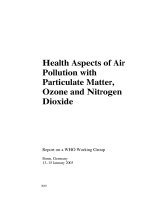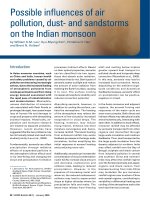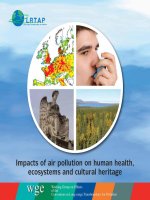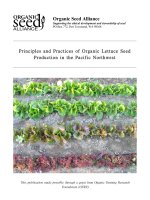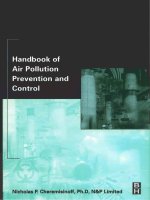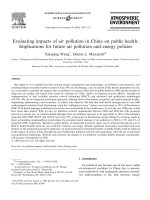Principles and Practices of Air Pollution Control: Student Manual pot
Bạn đang xem bản rút gọn của tài liệu. Xem và tải ngay bản đầy đủ của tài liệu tại đây (3.37 MB, 435 trang )
United States Air Pollution Training Institute (APTI) July 2003
Environmental Protection Environmental Research Center, MD E142-01
Agency Research Triangle Park, NC 27711
Principles and Practices
of Air Pollution Control
Student Manual
APTI Course 452
Third Edition
United States Air Pollution Training Institute (APTI) April 2003
ii
Environmental Protection Environmental Research Center, MD E142-01
Agency Research Triangle Park, NC 27711
Air
Principles and Practices
of Air Pollution Control
Student Manual
APTI Course 452
Second Edition
Authors
Dr. William Franek, PhD, PE
Mr. Lou DeRose, J.D.
Developed by
ICES Ltd.
EPA Contract No. 68D99022
iii
Acknowledgments
The authors gratefully acknowledge the contribution of Alpha Gamma Technologies,
Inc., whose preparation of SI:422 was used as the basis for this course development.
iv
Notice
This is not an official policy and standards document. The opinions
and selections are those of the authors and not necessarily those of the
Environmental Protection Agency. Every attempt has been made to
represent the present state of the art as well as subject areas still under
evaluation. Any mention of products or organizations does not constitute
endorsement or recommendation by the United States Environmental
Protection Agency.
This project has been funded wholly or in part by the United States
Environmental Protection Agency under Contract No. 68D99022 to ICES, Ltd.
Availability
This document is issued by the Air Pollution Training Institute, Education
and Outreach Group, Office of Air Quality Planning and Standards, USEPA.
This workbook was developed for use in training courses presented by the
U.S. EPA Air Pollution Training Institute and others receiving contractual or
grant support from the Institute. Other organizations are welcome to use
the document.
This publication is available, free of charge, to schools or governmental
air pollution control agencies intending to conduct a training course on the
subject matter. Submit a written request to the Air Pollution Training
Institute, USEPA, MD E142-01, Research Triangle Park, NC 27711.
Sets of slides and films designed for use in the training course of which
this publication is a part may be borrowed from the Air Pollution Training
Institute upon written request. The slides may be freely copied. Some films
may be copied; others must be purchased from the commercial distributor.
This consent does not extend to copying or transmission by any means
– graphic or electronic – for any other purpose, such as for advertising or
promotional purposes, for creating a new collective work, for resale, or for
information storage and retrieval systems.
State and local air pollution control agencies, U.S. EPA offices, and
federal offices designated by U.S. EPA are authorized to make copies of
this document in connection with telecourses.
Printed on recycled paper in the United States of America.
v
Course Description
APTI 452: Principles and Practices of Air Pollution Control is a three-day,
resident instructional course designed to present an introductory view of all
major, practical aspects of air pollution control. The course is intended primarily
for employees unfamiliar with governmental control of air pollution or those who
require a general knowledge of the principles and practices associated with air
pollution control. The lessons include information on control program history,
health and environmental effects of pollution, air pollution meteorology, air quality
management, ambient air quality monitoring, measurement and control of
emissions, pollution prevention, laws and regulations, emission inventories,
compliance and enforcement, and other related topics.
The course is taught at an instructional level equivalent to that of an
advanced, undergraduate university course. The Air Pollution Training Institute
curriculum recommends APTI 452: Principles and Practices of Air Pollution
Control as an introductory course for all areas of study. The student should have
minimally completed a college-level education and APTI Course SI:422 – Air
Pollution Control Orientation Course (3rd ed.) or have a minimum of six months
of applicable work experience.
How to Use This Manual
This manual is to be used during classroom instruction and telecourse
sessions. The workbook contains instructional objectives and materials for each
of the thirteen subject areas.
Each chapter provides a lesson goal, instructional objectives, subject
narrative, and reference materials that may guide your study. Each chapter
also contains a reproduction of selected lecture slides intended to guide
your notetaking. The slides are presented to generally follow the course
outline; however, the instructor may on occasion vary the order of presen-
tation or present material not included in the workbook. Each student,
therefore, should take thorough notes of the lecture content throughout the
course, but not rely solely upon graphic reproductions for the course
content.
vi
DISCLAMER
This document does not constitute U.S. Environmental Protection Agency policy.
Mention of trade names or commercial products does not constitute endorsement or
recommendation for use.
vii
TABLE OF CONTENTS
Table of Contents vi
Table of Figures vii
Table of Tables viii
Chapter 1: Control Program History 1-1
Chapter 2: Health and Environmental Effects of Air Pollution 2-1
Chapter 3: Transport and Dispersion of Air Pollution 3-1
Chapter 4: Indoor Air Pollution 4-1
Chapter 5: The United States Clean Air Act 5-1
Chapter 6: Ambient Air Quality Monitoring 6-1
Chapter 7: Measurement of Pollutant Emissions 7-1
Chapter 8: Emissions Inventory 8-1
Chapter 9: Control of Stationary Source Emissions (Particulate Matter) 9-1
Chapter 10: Control of Stationary Source Emissions (Gaseous Emissions) 10-1
Chapter 11: Control of Mobile Source Emissions 11-1
Chapter 12: Pollution Prevention 12-1
Chapter 13: Laws and Regulations 13-1
Chapter 14: Compliance and Enforcement 14-1
Appendix Final Exam A-1
viii
TABLE OF FIGURES
Figure 2-1 Upper Respiratory System 2-5
Figure 2-2 Lower Respiratory System 2-6
Figure 2-3 Bronchial Tubes 2-7
Figure 2-4 Susceptible Populations 2-8
Figure 2-5 The Greenhouse Effect 2-21
Figure 2-6 The Risk Assessment Process 2-25
Figure 2-7 Pollutant Effect, Human and Animal Studies 2-26
Figure 2-8 Exposure Modeling Factors 2-28
Figure 2-9 Dose-Response Relationship for Cancer 2-28
Figure 2-10 Dose-Response Relationship for Non-cancer Effects 2-29
Figure 3-1 Rotating Cup Anemometer 3-4
Figure 3-2 Wind Direction Vane 3-5
Figure 3-3 Air Pollution and Wind Rose 3-5
Figure 3-4 Looping Plume 3-8
Figure 3-5 Fanning Plume 3-8
Figure 3-6 Coning Plume 3-9
Figure 3-7 Lofting Plume 3-9
Figure 3-8 Fumigating Plume 3-9
Figure 3-9 Trapping Plume 3-10
Figure 3-10 Types of Pollutant Dispersion 3-13
Figure 6-1 Size Distribution and Sources of Atmospheric Particles 6-8
ix
Figure 6-2 Averaging Times for Gaseous Pollutants 6-11
Figure 6-3 Information Flow Across Monitoring Strategies 6-18
Figure 6-4 Components of NCore 6-19
Figure 6-5 Properties of the Atmosphere 6-20
Figure 6-6 Clean Air Status and Trends Network (CASTNET) Site Locations 6-21
Figure 6-7 Air Toxics Pilot City Sites and Proposed Trend Site Locations 6-24
Figure 7-1 Representative Point Selections 7-6
Figure 7-2 Isokinetic Sampling of Particles from a Stack 7-7
Figure 7-3 Isokinetic Conditions 7-7
Figure 7-4 Over Kinetic Conditions 7-8
Figure 7-5 Under Kinetic Conditions 7-8
Figure 7-6 Sampling Train for Particulate Emissions 7-11
Figure 7-7 Double Pass Opacity Monitor 7-12
Figure 7-8 System Source Monitoring Classification Diagram 7-13
Figure 8-1 Activities for Preparing an Inventory 8-4
Figure 8-2 Approach to Emission Estimation 8-6
Figure 8-3 CHIEF Web Site 8-10
Figure 8-4 Spatial Allocation of Emissions to Grid Cells 8-16
Figure 9-1 Venturi Scrubber 9-11
Figure 9-2 Electrostatic Precipitator 9-17
Figure 9-3 Fabric Filter 9-20
Figure 9-4 Settling Chamber 9-24
Figure 9-5 Cyclone Collector 9-26
Figure 10-1 Thermal Incinerator 10-5
Figure 10-2 Catalytic Incinerator 10-9
x
Figure 10-3 Flare System 10-14
Figure 10-4 Carbon Adsorber 10-19
Figure 10-5 Mass Transfer Zone (MTZ) 10-20
Figure 10-6 Packed Column Absorber 10-22
Figure 10-7 Contact Condenser 10-26
Figure 10-8 Surface Condenser 10-27
Figure 10-9 Flue Gas Desulfurization Technology Tree 10-28
Figure 11-1 Emissions and Emission Sources of Light-Duty Vehicles 11-7
Figure 11-3 Stage II Gasoline Vapor Recovery System 11-11
Figure 11-4 Basic Controls for SI Engine Exhaust and Evaporative Emissions 11-13
Figure 12-1 Pollution Prevention Hierarchy 12-11
Figure 12-2 Recycling Options 12-11
xi
TABLE OF TABLES
Table 1-1 Comparison of Air Quality Management Strategies 1-17
Table 2-1 Human Health Effects of Criteria Pollutants 2-16
Table 6-1 National Ambient Air Quality Standards 6-5
Table 6-2 Air Quality Index Descriptor Chart 6-14
Table 6-3 Relationship Among Monitoring Objectives and Scale
Representativeness 6-15
Table 6-4 Summary of Spatial Scales Applicable for SLAMS and
Required for NAMS for each Criteria Pollutant 6-16
Table 8-1 Emission Thresholds for Criteria Pollutants 8-5
Table 9-1 Industrial Process Operation Air Emission Points
and Categories 9-6
Table 9-2 Cumulative Particulate Matter Collection Efficiencies 9-16
Table 10-1 Thermal Incinerator PM
10
Destruction Efficiencies
by Industry 10-7
Table 10-2 PM
10
Destruction Efficiencies for Catalytic Incinerators
and Catalytic Incinerators with Heat Exchanger by Industry 10-12
Table 11-1 Summary Table of Alternative Fuel Advantages
and Disadvantages 11-17
xii
THIS PAGE INTENTIONALLY LEFT BLANK
CHAPTER 1
Control Program History
Lesson Goal
At the end of this lesson, you will demonstrate general understanding of and
familiarity with the historical overview of air pollution control, program history, and the
major legislative landmarks that have defined the parameters of air quality management
in the United States by successfully completing the review questions at the end of the
chapter.
Lesson Objectives
1. Identify the historic episodes and events that led to passage of air
pollution control legislation.
2. Discuss the five major influences that affected the development of air
quality management programs in the United States.
3. Explain the hierarchy of government responsibilities and discuss
the history of regulatory approaches by our local, state, and federal
governments as it relates to air pollution management.
4. Describe federal regulatory involvement from the Air Pollution
Control Act (1955) to the Clean Air Act Amendments (1990).
5. Explain the four regulatory strategies used in the development of an
air pollution management program, and describe the implementation
of our nation’s air pollution management program.
6. Discuss the possible future developments of air pollution
management.
Recommended Reading: Godish, Thad, “Regulation and Public Policy,” Air Quality, 3rd Edition,
Lewis: New York, 1997, pp. 237-286.
References
Boubel, R.W.; Fox, D.; Turner, D.B.; Stern, A., Fundamentals of Air Pollution,
San Diego: Academic Press, 1994, pp. 3-20.
Campbell, W.A. and M.S. Health, Jr., “Air Pollution Legislation and
Regulations,” A.C. Stern (Ed.), Air Pollution, Vol. IV, Air Quality
Management, 3rd Edition, New York: Academic Press, 1977, pp. 355-377.
Clairborne, M.L., “The New Air Toxics Program,” Natural Resources &
Environment, Fall, 1992, pp. 21-23, 54-55.
Committee for Economic Development, What Price Clean Air? A Market
Approach to Energy and Environmental Policy, Washington, D.C: Committee
for Economic Development, 1993, p. 96.
De Nevers, Noel, Air Pollution Control Engineering, New York, McGraw-Hill, Inc.,
1995, pp. 1-52.
Godish, Thad, “Regulation and Public Policy,” Air Quality, 3rd Edition, Lewis:
New York, 1997, pp. 237-286.
Goldsmith, J.R. and Friberg, Lars T., “Effects of Air Pollution on Human Health,” In:
A.C. Stern (Ed.), Air Pollution, Vol. II, Academic Press: New York, 1977, pp.
470- 474.
Martineau, R.; Novello, D. (Ed.), The Clean Air Act Handbook, American Bar
Association, 1998.
Patrick, D. (Ed.), Toxic Air Pollution Handbook, Air and Waste Management
Association, New York: Van Nostrand Reinhold, 1994, pp. 3-10.
Shy, Carl M., et al., Health Effects of Air Pollution, New York, American
Thoracic Society, Medical Section of American Lung Association, 1978,
p. 13.
Stern, A.C. (Ed.), Air Pollution, Vol. V, Air Quality Management, New
York: Academic Press, 1977.
Stern, A.C., “History of Air Pollution Legislation in the United States,”
Journal of the Air Pollution Control Association, Vol. 32, No. 1,
January 1982.
U.S. EPA, Air Pollution Episodes: A Citizen’s Handbook, GPO
Publication No. 1972-0-452-729, 1971.
U.S. EPA, Air Pollution Control Orientation Course, APTI SI: 422.
Wark, K.; Warner, C.; Davis, W., Air Pollution its Origin and Control,
Berkley, California: Addison Wesley Longman Inc., 1998, pp. 1-108.
Control Program History
ir pollution has been a public health
problem since the discovery of fire. In fact,
incidents and episodes of air pollution have been
documented throughout history. In ancient times,
people used fire inside their caves and huts, often
filling the air with harmful smoke. The Roman
philosopher Seneca noted the “heavy air of Rome”
in 61 A.D., and King Edward I strictly prohibited
coal burning in London in 1273.
The origin of modern air pollution problems can
be traced to eighteenth century England and the
birth of the Industrial Revolution. As
manufacturing replaced predominantly agricultural
activities, populations shifted from the countryside
to the city. What resulted was disastrous, as
burgeoning populations strained rudimentary
public utilities and services.
Energy that was desperately needed to heat
public housing was often diverted for industrial
purposes to fuel the ever-expanding Industrial
Revolution. Great plumes of smoke and fly ash
billowed from factories in the late eighteenth and
nineteenth centuries, and air pollution problems
escalated in the twentieth century with the advent
of the automobile. The problem of air pollution
grew in the mid-twentieth century, leaving
catastrophic effects on human health and the
environment in its wake.
Smoke, produced by burning coal and wood, was the earliest form of air pollution.
Smoke and ash produced by power plants contributed significantly to the problem of air
pollution in the late 19th and early 20th centuries.
By 1940, air pollution in the United States and
emerging public opinion pressured government
regulators to act. Smog formed around Los
Angeles, while other metropolitan areas around
the country began to report degradations in air
quality and visibility. Growing familiarity with
environmental issues and increased public
pressure hastened federal and state action.
California was the first state to pass air
pollution regulations. Shortly after California acted
in 1947, the federal government convened the first
National Air Pollution Symposium composed of the
leading environmental specialists and government
representatives of the day. This landmark
symposium marked the introduction of federal
government involvement in environmental
regulation.
In 1955, upheld by strong public support and
improved science, Congress passed its first
environmental legislation. From these meager
beginnings the U.S. Environmental Protection
Agency and an effective public policy toward the
environment were instituted.
Air Pollution Control
Programs
Five major influences that brought about the
development of air pollution programs in the U.S.
were air pollution episodes, improvements in
science, environmental activism, changes in
society and economy, and increased public
awareness.
Air Pollution Episodes
Air pollution episodes result from the buildup of
air pollutants and are often associated with a
temperature inversion. Such episodes of high
pollutant concentration have negative effects on
public health and the environment. The six most
notorious events occurred across three continents
over a period of only 50 years. These represent
the most deadly events associated with air
pollution in the twentieth century. They provide
direct evidence of the destructive capacity of
modern air pollution.
By the 1940s, smog formed around Los Angeles and the first state environmental
legislation was passed.
In 1955, Congress passed the first federal environmental legislation − the Air Pollution
Control Act.
Muese River Valley (1930). The best known
of the acute air pollution episodes occurred when
pollutants were trapped in the Meuse River Valley
of Belgium. Public officials observed a significant
increase in reports of human death and illness
when the concentration of air pollution was at its
highest. Sixty-three people died in the first week
of December 1930, prompting public health
officials to examine the relationship between these
deaths and high concentrations of SO
2
in the
atmosphere. Their findings revealed that weather
patterns had a significant impact on sulfur dioxide
concentrations, particularly during periods of
temperature inversion (Shy, 1978).
Donora, Pennsylvania (1948). In the early
morning hours of October 26, 1948, a temperature
inversion coupled with foggy weather settled over
a horseshoe-shaped valley along the
Monongahela River near Pittsburgh. Nestled in
this valley was a small town of about 14,000
people—most were employed by the local steel
mill, sulfuric acid plant, or zinc production facility.
Twenty people died over a three-day period,
largely due to cardiac and respiratory diseases.
About half of the remaining population complained
of cough, respiratory tract irritation, chest pain,
headaches, nausea, and vomiting. Environmental
experts agreed that the high concentrations of
sulfur dioxide were largely responsible for these
deaths and illnesses in Donora, Pennsylvania
(Goldsmith and Friberg, 1977).
Poza Rica, Mexico (1950). Another
catastrophic air pollution episode occurred in the
small town of Poza Rica, Mexico when a natural
gas plant released a toxic substance into the
atmosphere. On the morning of November 24,
1950, the weather was foggy, winds were light,
and an inversion layer had settled over the area.
Shortly before sunrise, the plant began refining
natural gas, releasing deadly hydrogen sulfide into
the atmosphere. The poisonous gas was trapped
near the ground, resulting in the deaths of 22
people and the hospitalization of another 320.
The pattern was apparent: characteristic weather
conditions, coupled with the toxic release of
chemicals, were responsible for these deaths
(Goldsmith and Friberg, 1977).
London Fog (1952). The episode that proved
to be the most dramatic and costly to human
health occurred in the London Fog of 1952. In a
five-day period, a temperature inversion covered
the Thames River Valley, trapping deadly acid
aerosols in the atmosphere. More people died in
this acute air pollution event than in any other
episode in
Sixty-three people died in the Muese River Valley due to exposure to high concentrations
of SO
2
.
Over 4,000 people died in 1950 when a deadly temperature inversion settled over
London.
recorded history. Over 4,000 people succumbed
to bronchitis, pneumonia, and respiratory and
cardiac disease. Because the death rate was so
alarming, the British
Parliament reinstated King Edward’s thirteenth
century precedent and immediately barred the
burning of soft coal in London (Shy, 1978).
Unfortunately, only ten years later a similar
incident claimed an additional 700 lives. Historical
records reveal the 1952 incident was not the only
recorded event of its kind. Records also indicate
there were detectable increases in deaths
associated with fog in December 1873, January
1880, February 1882, December 1891, and again
in December 1892. In total, 300 people died in the
winter of 1948, while another 700 perished from
particulate poisoning in 1963 (Goldsmith and
Friberg, 1978).
New York City (1953). From November 15-
24, 1953, approximately 200 people died of
cardiac and respiratory ailments. Not surprisingly,
records of a substantial increase in sulfur oxide
concentrations coincided with a widespread
atmospheric lull along the eastern seaboard of the
United States at this time. Once again, substantial
evidence warned public health officials of an
impending crisis, yet accumulating weather data
was not linked to health complaints until much
later (Goldsmith and Friberg, 1978).
Bhopal, India (1984). Several decades
passed before an event of these proportions
occurred. On December 3, 1984, an incident took
place that is noted as the world’s most deadly
industrial accident. A Union Carbide pesticide
plant accidentally leaked a highly toxic and
poisonous gas into the slums of Bhopal, India. As
Bhopal’s citizens slept, they were helpless in
protecting themselves from the toxic gases that
overcame them. Over 4,000 people died instantly
of methyl isocyanate poisoning, while hundreds of
thousands were permanently disabled, blinded, or
injured. Today, the Indian government estimates
an additional 15,000 deaths can be directly linked
to the gas leak, while more than 500,000 people
had unresolved claims pending before Indian
courts late into the last century (Cohen, 1994).
Air pollution events such as these graphically
demonstrate the fragile nature of human health
and the environment and the disastrous effects
that air pollution can have on both. Continued
concern over events such as these has resulted in
environmental legislation aimed at preventing such
occurrences in the future.
Due to increased concentrations of sulfur dioxide and atmospheric inversions along the
East Coast, over 200 people died in New York City.
Improvements in Science
As a result of air pollution episodes and public
outcry about the Los Angeles smog problem,
public policy initiated a search to find answers and
causes. Researchers explored human health and
the environmental effects of air pollutants. This
research paved the way for improvements in
science.
Air Pollution research began in California when
the City and County of Los Angeles, and later the
State of California, studied its smog problem.
Around 1950, California Senator Thomas Kuchel
appealed to the U.S. Congress stating that air
pollution research efforts and costs should be
borne nationally rather than exclusively by
California. In 1955, President Eisenhower and
Congress responded by passing legislation that
provided for research on the health effects of air
pollution.
In the early 1950s, Professor A.J. Haagen-
Smith studied the Los Angeles smog problem and
proved that, under ultraviolet irradiation, organic
compounds and oxides of nitrogen react to
produce smog. He demonstrated eye irritation,
damage to green leaves, and light-scattering
characteristics were byproducts of smog that were
largely formed from emissions from autos reacting
in sunlight.
Later, in 1963, P.J. Lawther used daily
mortality and morbidity data to conclude that
increased mortality results when sulfur dioxide
levels exceed 0.71 mg/m
3
and suspended smoke
exceeds 0.75 mg/m
3
. Around 1965, the U.S
undertook a major effort. to study the human
health effects of specific pollutants. The purpose
was to establish a causal relationship between
diminished air quality and human disease and
death. Pollutant studies included sulfur dioxide,
particulate matter, oxidants, carbon monoxide,
hydrocarbons, and nitrogen oxides.
Improvements were also made in science by
the creation and growth of environmental health
science and the increased quality of scientific
research. By 1980, air pollution meteorology
came of age and mathematical models of the
pollution of the atmosphere were created. In
addition, a wide variety of measuring instruments
were developed to meet the pressing need for air
quality monitoring systems.
Professor A.J. Haagen-Smith was one of the early pioneers to establish the link between
smog and automobile emissions.
In 1963, P.J. Lawther advanced scientific understanding about the important link
between human mortality and morbidity and pollutants in the atmosphere.
Over the last thirty years environmental
science has become a discipline in itself,
generating business and increasing the need to
document and improve its knowledge base. This
has led to a variety of scientific views, sometimes
in support while at other times in opposition, but
always directed toward refining the question of
“What is good science?” and “How much do we
have to know before we take action?”
Changes in Society and Economy
Population growth, industrialization, increased
wealth and changing societal attitudes were
among the significant changes that took place in
our nation from about 1860 to 1960. These
changes in society and the economy served as the
third largest influence on air pollution programs.
In the late 1800s, some of the principal causes
of death were infectious diseases such as
influenza, tuberculosis, typhoid fever, malaria and
venereal disease. As knowledge of and treatment
for these diseases has improved, our average life
span has increased from 40 to 75 years. As a
result, many now survive long enough to die of
long-term diseases such as arteriosclerosis, heart
attacks, stroke, emphysema, and cancer. All of
these long-term diseases can be related to
environmental factors—including air pollution.
With more people living longer and many dying of
air pollution related diseases, our nation is
increasingly concerned with the development of a
cohesive air pollution control strategy.
The industrial revolution, which began in
England in the 18th century, ultimately provided a
higher standard of living through increased wages.
This industrialization, while proving extremely
beneficial for individual standards of living, had an
immensely negative impact on the environment.
Innumerable smokestacks decorated the
landscape, spewing harmful toxins into breathable
air. With the invention and proliferation of the
automobile, our nation experienced a rapid growth
in fuel consumption. Increases in such
consumption caused the air pollution problem to
proliferate from large cities to rural areas, creating
unhealthy and unsightly smog.
Environmental concerns are a luxury only a
wealthy nation can afford. While the poor were
consumed with
Population growth, industrial-ization, increased wealth, and changing social attitudes
were important factors that paved the way for increased concern about environmental
issues.
attaining basic necessities, air pollution failed to
gain importance. Those who participated in the
environmental awaking were members of the ever-
growing American middle class. Changing social
attitudes were now more concerned with quality of
life issues such as environmental protection.
Environmental Activism and Public Awareness
The final two influences on the development of
air pollution control programs were an increased
public awareness to environ-mental issues and the
birth and development of environmental activism
in this country.
Modern day concerns about the environment
grew in the 1960’s, with the surfacing of social
revolution in the United States. Concern about the
environment took its place alongside civil rights,
consumer protection, safety and health, and a host
of other issues that were on the public agenda at
the time. The environmental movement that
began in the 1960s was initially concerned with air
and water pollution. Environmental activism was
sparked by Rachel Carson’s book Silent Spring,
which revealed the problems of increased and
unrestricted pesticide usage.
Carson connected the findings of toxicology,
ecology, and epidemiology in a form easily
understood by politicians and the general public.
She discussed the bioaccumulation of fat-soluble
insecticides in fatty tissues of fish and the birds
that eat fish, the natural resistance of surviving
insects to these toxins, the natural dispersion of
the toxins far from the source of the substance.
As a result of Carson’s writing and other concerns
expressed in society, people became more
educated about the environment and its
importance to human beings.
Environmental activism grew in the 1960’s, and
a worldwide Earth Day was organized in the spring
of 1970—Earth Day has since become an annual
observance dedicated to the awareness of
environmental problems. Energized
environmental activism brought about the
establishment of several environmentally
concerned public interest groups. Among these,
the Sierra Club lobbies Congress on
environmental issues ranging from nuclear energy
to wetlands preservation, and the Natural
Resource Defense Council blocks economic
development in courts by suing firms for failure to
pay adequate attention to environmental laws.
Other environmental organizations
Earth Day was first celebrated in the spring of 1970, and was one of the first precursors
of environ-mental activism in the United States.
include The Friends of the Earth, The National
Wildlife
Federation, Environmental Action, Environmental
Defense Fund, and The Nature Conservancy.
Today, private environmental organizations like
these play an important role, not only in shaping
public policy but advancing effective
environmental education. Since 1971, the
National Association for Environmental Education
and other organizations like it have become an
essential forum for teachers, conservationists,
naturalists, and scientists to advance
environmental viewpoints and perspectives.
Hierarchy of Government
Responsibilities
The hierarchy of governmental air pollution
responsibilities involves a top-down approach.
The Federal Clean Air Act, while using federal
oversight, mandates certain responsibilities to
state governments, which in turn delegates certain
responsibilities to local governments. Today, we
have the hierarchy of government responsibilities,
but historically air pollution was considered a local
matter that was to be handled on a local level.
Local Governments
Before 1900, disputes about unwanted material
in the air were resolved by common law nuisance
(public or private) or trespass litigation.
Thereafter, air pollution abatement under the
nuisance doctrine gradually gave way to resolution
by local governmental ordinances. In 1881,
Chicago and Cincinnati were the first to pass air
pollution laws. These ordinances regulated smoke
emissions from furnaces and locomotives. By
1920, 175 municipalities had air pollution
ordinances, and by 1940 this number grew to over
200.
These ordinances defined smoke as dense,
black, or gray opacity. Problems with this
definition led to the adoption of the Ringelman
Chart for percent opacity. Originally most
communities prohibited smoke darker than No. 3
on the Ringelman scale (60% opacity). Since
then, there has been a progressive decrease in
allowable smoke
Air pollution complaints were originally litigated through common law nuisance or
trespass provisions before 1900.
density. Today, the majority of opacity ordinances
prohibit opacity greater than 20%.
State Governments
At the turn of the century, courts of law
expanded state authority by finding air pollution
control actions were within Tenth Amendment,
“police power” of the state, statutes. In 1910 and
1912 respectively, Massachusetts and Rhode
Island were the first states to pass air pollution
(smoke control) laws. In 1947, California was the
first state to pass laws regulating air pollution
beyond regulating black smoke emission from
industrial stacks. This law gave authority to
counties to regulate air pollution. Oregon, in 1952,
passed the first state law that provided statewide
authority to a state air pollution control agency. In
1956, California formed its first state air pollution
control agency and to address air pollution
